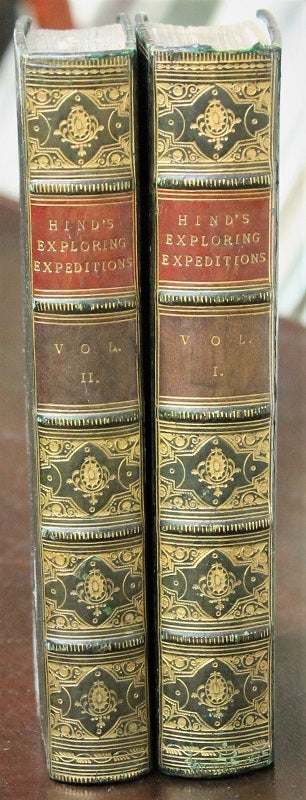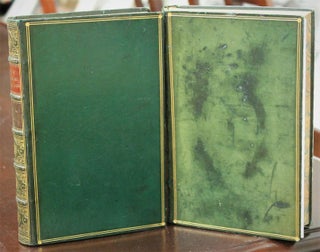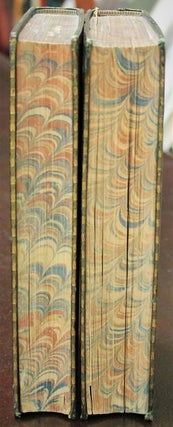Narrative of The Canadian Red River Exploring Expedition of 1857 and of the Assinniboine and Saskatchewan Exploring Expedition of 1858.
Longman, Green, Longman, and Roberts, Spottiswoode and Co., 1860. Edition: London, Binding: Full original green calf boards. Double gilt framing on upper and lower. Spine with 5 raised bands, gilt scores on bands, compartments densely gilt with title and vol. number in gilt lettering on red and brown labels in compartments 2 and 3 respectively. Decorative gilt rolls on board edges. Blind dentelles. Marbled paste-in and free endpapers. All edges marbled. , Notes: Henry Youle Hind (1823 – 1908) was a Canadian geologist and explorer. Hind led expeditions to explore the Canadian prairies in 1857 and 1858. Hind’s accounts of his expeditions to the Red and Assiniboine River valleys in 1857 and to the Souris, Qu-Appelle, and South Saskatchewan River valleys in 1858 were integral in supporting movements for European settlement in these regions.
Hind’s research was prompted from a need to find new agricultural land in Canada; in the 1850s, Canada saw an increase in immigration, and agricultural land was becoming scarcer and more expensive to acquire. Since new land was needed, explorers like Hind sought to expand colonization in the west through expeditions such as these with the intention of proving that the previously uninhabitable fur trade lands of the North-West would be useful for such development.
In his report, Hind was to collect information on topography, vegetation, soil, and meteorological observations. Ultimately, the work of Hind and John Palliser (leader of the British expedition) redefined public opinion and the perceived geography of the North-West. They created the idea of two vast sub-districts: Palliser’s Triangle consisted of poor soil and was arid and uninhabitable; Hind's discovery, called the Fertile Belt, stretched from the Red River Settlement to the Saskatchewan River Valley and the Rocky Mountains. They reinforced the myth of ‘good land’ in the north of Saskatchewan and the myth of ‘bad land’ in the interior.
, Size: 8vo. (215x140 mm), Illustration: Complete with 28 beautifully hand coloured plates and maps (19 in vol. 1, 9 in vol. 2), including 3 folding plates, in addition to many woodcuts throughout both volumes. Some discoloring of leather on vol. 1. Hinges split. Mis-pagination. in vol. 2, 168 as 186. , Volume: 2 volumes., Provenance: Ex-Libris ‘P.G.’: book label on verso of front free endpaper in vol. 2. Vol. 1 with handwritten inscription/note of presentation on first leaf, dated 1867., References: Abbey, Travel, 630; Field 699; Graff 1892; Lande 1235; Pilling, Siouan, p. 36; Sabin 31933; Wagner-Camp 361., Pages: Vol. 1: Blank (2). Half title. Blank. Title. Blank. Preface (v-vii). Blank. Contents (ix-xviii). List of illustrations (xix-xx). P. 1-494. Blank (2). Vol. 2: Blank (2). Half title. Blank. Title. Blank. Contents (v-xiv). List of illustrations (xv-xvi). P. 1-472. Blank (2)., Category: Book Canada;. A fine example in gilt full period calf. Interior is clean and crisp. Item #B6809
Price: $1,950.00





